Thank you, Simon, for your PAYPAL-transfer.
"My" Leach-amplifier has been sold. Please: do not respond to my offer anymore.
Regards - Rudi_Ratlos
"My" Leach-amplifier has been sold. Please: do not respond to my offer anymore.
Regards - Rudi_Ratlos
Oh no, another amp to build...lol
I still have a Stasis amp, a JLH amp and another KSA50 clone to build...
I'm looking forward to it...
Thanks Rudi
I still have a Stasis amp, a JLH amp and another KSA50 clone to build...
I'm looking forward to it...
Thanks Rudi
I constructed this amp and replaced the zeners with a 40 volts shunt regulator. What an improvement in the low level sounds.
gajanan phadte
What regulator did you use?
Thanks.
Can you post it how you implanted this ?I constructed this amp and replaced the zeners with a 40 volts shunt regulator. What an improvement in the low level sounds.
gajanan phadte
Just remove the 40volt Zener and the resistor connected to it. Assemble the shunt regulator and connect it's output at the zener terminals watching the polarities.
Do not forget T12 & T13 need some heatsinking .... make shure the artwork leave some extra space ..
Years ago, before Mr Leach died, I did print all the stuff about this amplifier and I still have all that stuff.
Years ago, before Mr Leach died, I did print all the stuff about this amplifier and I still have all that stuff.
I'd be interested, can't start a message chain because I'm new, but I think you can message meStill sat on my shelf if someone wants to buy it.
I'll post a few pictures here...
Attachments
-
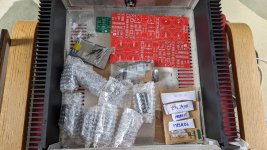 PXL_20240218_124726023.jpg534.3 KB · Views: 97
PXL_20240218_124726023.jpg534.3 KB · Views: 97 -
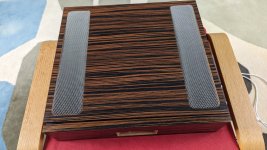 PXL_20240218_124750574.jpg546.4 KB · Views: 94
PXL_20240218_124750574.jpg546.4 KB · Views: 94 -
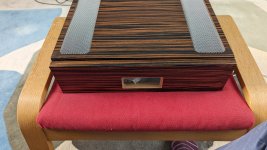 PXL_20240218_124753364.jpg533.1 KB · Views: 90
PXL_20240218_124753364.jpg533.1 KB · Views: 90 -
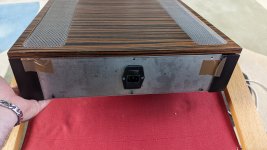 PXL_20240218_124956899.jpg500.6 KB · Views: 92
PXL_20240218_124956899.jpg500.6 KB · Views: 92 -
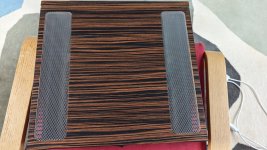 PXL_20240218_125006378.jpg576.8 KB · Views: 86
PXL_20240218_125006378.jpg576.8 KB · Views: 86 -
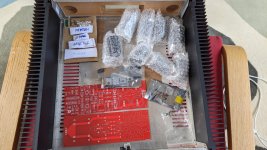 PXL_20240218_125024228.MP.jpg484.4 KB · Views: 96
PXL_20240218_125024228.MP.jpg484.4 KB · Views: 96 -
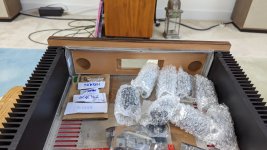 PXL_20240218_125031635.jpg380.4 KB · Views: 99
PXL_20240218_125031635.jpg380.4 KB · Views: 99
No need for tripple emitters with modern devices, back then it was needed to keep transistors in SOA area, cause of the high voltage rails.
I did the super leach and the cabeling for 16 to3 was very time consuming.
I did the super leach and the cabeling for 16 to3 was very time consuming.
You are confusing “triple emitter followers” with other features of the Leach designs. There is still value in using EF3 even with modern devices - even the high fT sustained beta types. And it has nothing to do with SOA - the same problems exists EF2 or 3. Stacked series devices are not needed today at normal operating voltages, up to about +/-85V. Use MJ2119x and put them all in parallel. The flat packs can be used too, just add an extra pair. If using 3281/1302 add two pair and it’s plenty. If you’re going even higher on the voltage, stick with the series/parallel stack. I’ve done it up to +/-127V with MJ21193/4, and even higher with the rail voltages switched. The non-super +/-50 volt version is just fine with two pair of pretty much any modern audio device - flat or TO-3, high or low fT. If in doubt on SOA just go to three. And it will always be better as an EF3 rather than cutting it down to a 2.
All that TO-3 wiring is VERY time consuming and responsible for 99% of oscillation problems experienced with these amps. The design is inherently very stable and can swap out outputs and drivers for faster ones with no issue. It’s all layout layout layout. Want to save a bunch of trouble? Take the time to design your own PCB using flatpacks. Stay with the stacked outout stage, go all parallel - up to you. The time spent on the board will be saved in spades in assembly and troubleshooting.
If you think a little outside the box you can come up with ways of doing a TO-3 based design with all PCB construction. More than one board, pluggable board-to-board connectors. They are inexpensive and solve a LOT of wiring headache.
All that TO-3 wiring is VERY time consuming and responsible for 99% of oscillation problems experienced with these amps. The design is inherently very stable and can swap out outputs and drivers for faster ones with no issue. It’s all layout layout layout. Want to save a bunch of trouble? Take the time to design your own PCB using flatpacks. Stay with the stacked outout stage, go all parallel - up to you. The time spent on the board will be saved in spades in assembly and troubleshooting.
If you think a little outside the box you can come up with ways of doing a TO-3 based design with all PCB construction. More than one board, pluggable board-to-board connectors. They are inexpensive and solve a LOT of wiring headache.
EF3 is needed because EF2 does not have enough current gain to avoid loading the VAS especially with a 4 ohm load.
Ed
Ed
With modern sustained beta drivers and outputs, the argument usually given is that it is a light enough load for the VAS in EF2. While that may be true, and the amplifier will work, it is still better in EF3.
People don’t like EF3 because they are afraid of it. It costs some phase margin, all other things being equal. There’s more thermal drift in general, but there are ways of dealing with that too. The other thing people don’t seem to get is that EF3 is very tolerant to running lower than optimum (26 mV across Re) bias. Especially when driven from a relatively low source impedance (as in original Leach low TIM design). So if it does overcompensate a little it’s not the end of the world.
People don’t like EF3 because they are afraid of it. It costs some phase margin, all other things being equal. There’s more thermal drift in general, but there are ways of dealing with that too. The other thing people don’t seem to get is that EF3 is very tolerant to running lower than optimum (26 mV across Re) bias. Especially when driven from a relatively low source impedance (as in original Leach low TIM design). So if it does overcompensate a little it’s not the end of the world.
I think the EF3 being more susceptible to self-oscillation scares people. An emitter follower is bidirectional: some output gets fed back to the input. The effects can be mitigated by adding base resistors.
Ed
Ed
- Home
- Amplifiers
- Solid State
- Professor Leach Amplifier